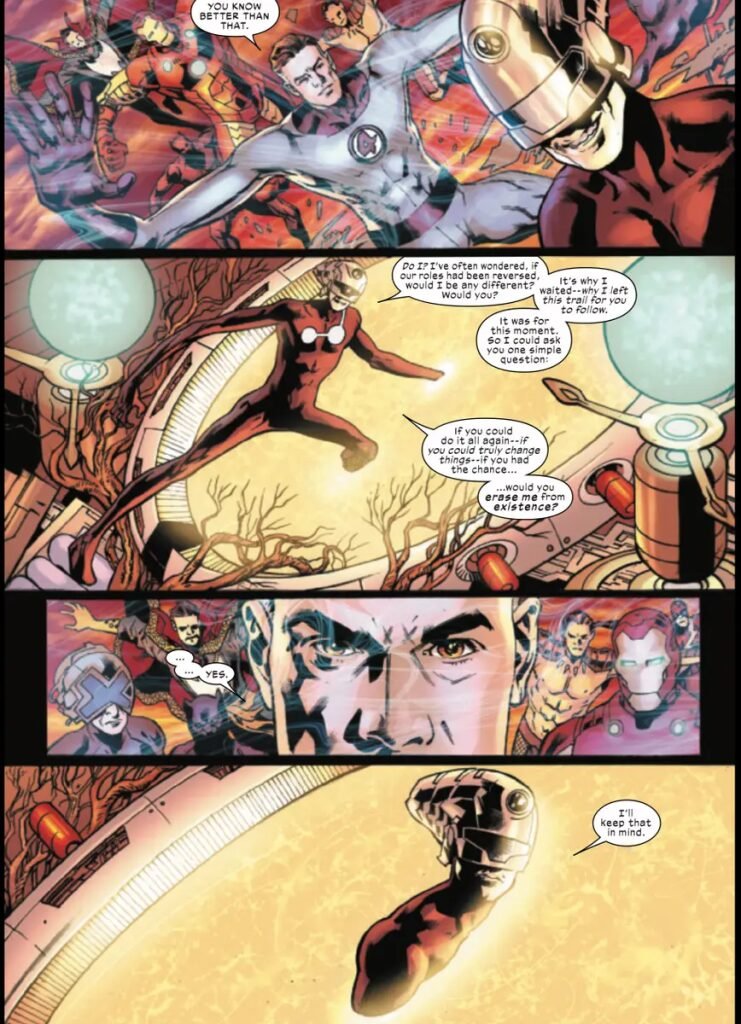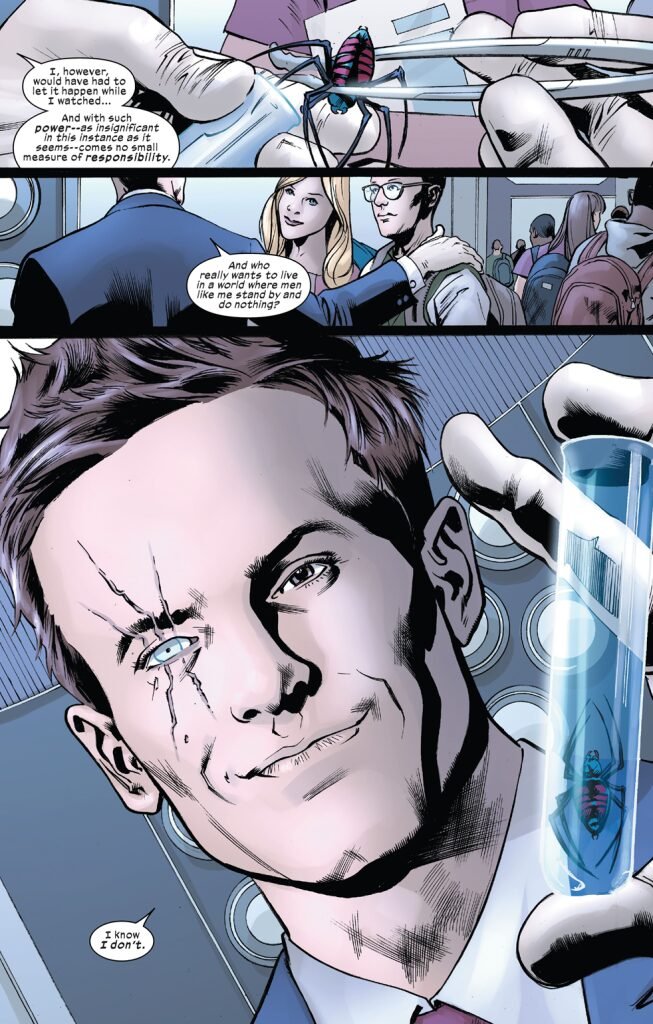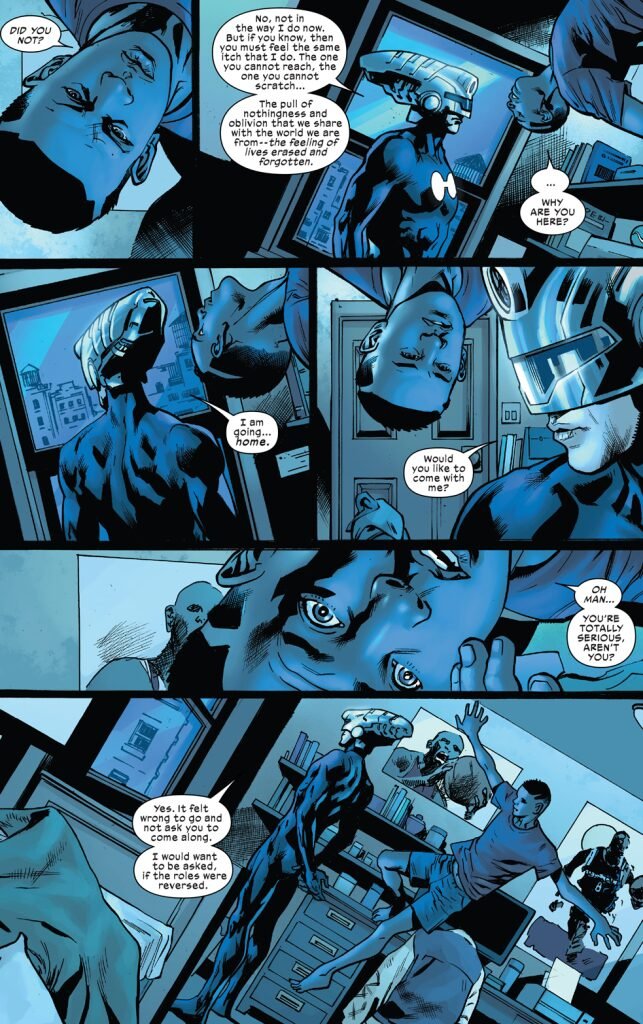Writer: Jonathan Hickman
Penciller: Bryan Hitch
Marvel Comics, August 2023
Warren Ellis watched it unfold, back in 2000. In Come in Alone, a collection of his essays on the American comic book industry, Mr Ellis railed against myopic superhero fans who did not want the impenetrable continuity of Marvel Comics to be replaced by something slicker, cleaner, and without the baggage – the Ultimate line.
American publisher Marvel Comics catalogues its superhero universes by number: Earth-616 is where most of its characters have their adventures, but the Ultimates universe is Earth-1610. (We use both terms interchangeably in this review.) On Earth-1610, Captain America is President of the United States; Iron Man is a nervous wreck with an alcohol problem and like a moon launch each of his missions are supported a huge team of scientists; Ant-Man is violently abusive to the Wasp; Scarlet Witch and her brother Quicksilver appear to have an incestuous relationship; and Spider-Man is dead.
The Ultimate universe was extinguished in 2015 in a title called, unimaginatively, Ultimate End. The labyrinthine continuity of Stan Lee and Jack kirby, in its sixties, prevailed. Marvel’s experiment with violent post-modernism continuity lasted a mere 15 years. (No doubt the haters from 2000 would have been triumphant at the Ultimate lines slow descent even as they switched from message boards to social media.)
But in American superhero comics no concept remains idle. The promotional copy from Marvel Comics on this title reads as follows:
THE TRANSFORMATION OF THE MARVEL UNIVERSE BEGINS! Superstar creators Jonathan Hickman and Bryan Hitch team up! The Illuminati must form once again to stop the Maker from his plans to destroy – or perhaps rebuild – the universe, with Miles Morales at the center of it all! Bryan’s work on THE ULTIMATES helped redefine super hero comics for the 2000s – wait until you see what he and Jonathan have in store for this decade! Including new data pages by Jonathan Hickman – plus exclusive behind-the-scenes material on the world-building that has gone into this project!

The artist is Bryan Hitch. As noted in the marketing pitch, more than anyone outside of writer Mark Millar, Mr Hitch is firmly associated with Marvel Comics’ Ultimates universe. Mr Hitch promulgated the “big screen” concept of superhero comic book art: that action should take place from high angles with visual dynamics at grand scale, often with maximum destruction. Such high-octane storytelling had readers giddy back in 2000 when the Ultimates universe was established, and soon, it is fair to say, everyone was doing it.
Mr Hitch’s art is otherwise very distinctive for its pleasing fluidity of form, together with a furrowed-browed intensity of character expression. Many of his characters look constipated, angry, or both. Surprisingly, this first issue had not much of either. Indeed, the principal antagonist, called The Maker, is mostly depicted with a thoughtful smile.

The Maker is Earth-1610’s version of Reed Richards of the superhero team, the Fantastic Four. Richards is usually depicted as the smartest man on Earth, capable of easily creating highly advanced technological innovations fit for purpose. Richards is an eccentric altruist. But the Maker is definitely not. The Maker had benign beginnings in the title Ultimate Fantastic Four (2004) as a geeky teen scientist, bullied at school and awkward with girls. The Fantastic Four’s reset in Ultimate universe was positively charming, reaching its peak, perhaps, with the Ultimate Galactus Trilogy (2004-2006). But by 2011, the character has been dumped by his girlfriend Sue Storm, his superhero team has disbanded, and his moral compass adrift.
In this issue, the Maker is genuinely terrifying. He is trapped in a cell, naked, so there is nothing he can use to transform into a weapon. It is not enough. His rescuers are a team of mercenaries armed with the Maker’s highly advanced weaponry (including a wonderfully depicted singularity grenade – a bomb which when it explodes looks like the 2019 image of the supermassive blackhole of Messier 87 created by NASA’s scientist. Once, a black hole would have looked like a sucking bathroom drain. Times have moved on.) The Maker betrays them, turning them quite horribly into a genetic duplicate of himself. The Maker then darts around stealing various devices from superheroes, and builds himself an interdimensional time machine. It is clear that he is to to save Earth-1610 by ensuring that those superheroes who are responsible for its downfall never develop their superpowers.
Before the Maker departs, he visits Miles Morales, also from Earth-1610, and offers him passage. Miles is the original Spider-Man’s successor, popular enough to be transported by Marvel Comics’ editors to Earth-616 before Earth-1610’s publication history wound up. Miles says no.

One of the nicer touches which Marvel Comics has previously deployed and which appears again here is that the Maker speaks at a whisper, reflected in the lower-case font in word balloons. This distinctive font also happens to be the same as that used in the Ultimate line of comics.
So far, so good, for an American superhero tale. Setting aside the time travel elements, the need to understand the backstory, and the inevitable superhero brawl against an unbeatable bad guy which is an indicia of so much of Marvel’s output, it reads well. Writer Jonathan Hickman’s name to the cover is an indicator of quality, and indeed is the only reason we picked up this issue. Sometimes it takes the goodwill of a writer, rather than a half-abandoned concept, to generate a sale. (Mr Ellis predicted that, too, in Come in Alone.)

